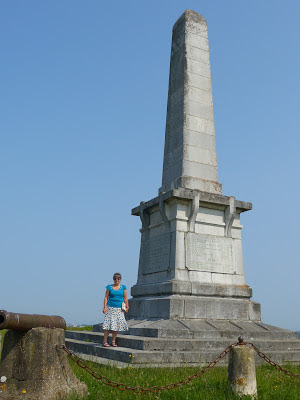We’re
staying at Hendaye, which feels rather home like. It’s got a lovely beach and late
Edwardian promenade, and the thing that makes it feel homelike is the wind;
there are lots of people on the beach trying to get out of the wind, or trying
to get out of wet swim suits, while wrapped in flapping towels. They need, but
don’t have, windbreaks. I know the idea of going on a beach when a windbreak is
needed is something that amuses some people, but we native north easterners
know their value.
 |
| The view from our hotel balcony |
It’s also
where Franco met Hitler in 1940, and where Wellington’s troops crossed the
Bidassoa into France.
Soult was busily
building redoubts and fortifications, but he believed the Bidassoa couldn’t be
crossed, and the weakest point of his line was near the sea. Wellington was
keen to keep in close touch with the navy and his supplies, and had discovered
from local shrimpers that the river could be forded in the estuary at low tide.
On October 7th 1813, local guides led the troops across, armpit deep
in the Bidassoa. At the same time, the Light division took La Rhune, in a
brilliant attack.
We can see
La Rhune. There’s a rack and pinion railway up it. It’s amazing to me that the
men got up it and were in a condition to fight when they reached the top. There’s
been so many times in these expeditions when we have scarcely been able to
believe the soldiers’ fitness and stamina. I suppose only those who could keep
up survived.
Today we
went to San Sebastian. The trip started poorly – most of San Sebastian is an
unlovely modern city, and we were a bit sulky and regretting making the effort.
However
when we got parked near the main beach, it turned into a grand day out. We
spent ages going round the rocky promontory, Monte Urgell, and the
fortifications on top of it, Castillo de la Mota. Franco put a huge statue of
Christ on the top. The old citadel has been made into a museum of the history
of San Sebastian, with a lot of emphasis on the tourism, so there were some
brilliant old films of the twenties and thirties. There’s a royal villa, where
the royal family used to holiday. It looks lovely, but I doubt whether Juan
Carlos has holidayed there – San Sebastian (or Donostia) is apparently a hotbed of Basque nationalism.
A lot of signs are only in Basque.
Anyway,
Wellington needed to take San Sebastian. He couldn’t just blockade it, because
it kept being resupplied by sea. Wellington got very ratty with the Royal Navy,
but I suppose it was too hard to catch every little cutter when the fogs came
down.
The town
walls were much weaker than those of the citadel, so the British attacked the
town. The first assault, on July 25th, failed, and Colonel Sir
Richard Fletcher, Wellington’s brilliant chief engineer, responsible for the Lines
of Torres Vedras, was killed.
 |
| Citadel at the very top of the picture, taken from the riverside walk. Why the town was assaulted, not the citadel. |
By 31st
August, the guns had battered a breach in the east wall, and the troops waded
the river at low tide. By this time the artillery was so reliable and accurate
that they fired over the heads of their own troops, which was unheard of, and
managed to ignite the French magazine. Then having got into the town, the
British and Portuguese went on the rampage. It was only stopped by the fact
that the entire town was on fire.
 |
| The gate of the citadel, from where the French commander finally surrendered, 9 days after the city had fallen. |
We noticed
that it is still a very sore topic in Donostia. There’s a street called 31st
August, where there are memorial ceremonies every year. Some of the signs in
the museum, and the Spanish government of the day, implied that the fire was
deliberately started. Wellington always denied this, and it does not seem a
necessary explanation, in a town which had been heavily shelled and a powder
magazine exploded.
A note on
food – you may have noticed a lot less about where and what we ate than you
usually have to plough through. This is because the food has been largely
disappointing. There are some very posh looking “new Basque cuisine”
restaurants, if one is prepared to fork out £70 a head. But everywhere else has
been OK, and that’s the best I can say.








































